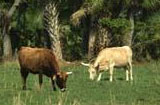Florida’s Ranches:
Ecology & Economics
Ranching is an important part of Florida’s economy and environment. About thirty percent of Florida’s acreage was used for farmland in 2003, the majority being used for cattle. In that same year, cattle production contributed more than 348 million dollars to the state’s economy. Besides economic contributions, ranching protects water resources, provides areas for wildlife and recreation, and preserves natural landscapes.
Economy
Florida is a large cattle state and most ranches are cow-calf operations that produce calves for the national cattle market.
In addition to generating income, Florida’s ranches contribute to the state and its citizens in the form of taxes. While agricultural lands have lower tax rates than other properties, they also use fewer services. Agricultural properties use an average of forty cents for every tax dollar collected in services. This results in a net tax contribution to the state for use by its citizens.
Despite this positive balance on the state economy, the number and acreage of ranches decreases every year. The cyclical and precarious nature of the ranching economy leads to unpredictable costs for ranchers, which in turn causes declining numbers of ranchers and grazing lands. Land that is taken out of production is often developed.
Environment
Grazing Lands
Ranchlands can support as few as eighteen to as many as hundreds of animals per square mile. The type of forage available is an important factor in determining this rate. Florida’s main grazing lands are:
- Improved pasture—planted with an introduced higher forage value grass
- Unimproved pasture—introduced grass not managed for high production
- Native range—open native plant communities
Ranches in the northern part of the state are generally improved pasture with small herds. South Florida’s ranches are larger and are more apt to include unimproved pasture or native range.
All ranchlands, even native range, require management. Ranchers use prescribed burning, chopping, and controlled grazing as management tools for range and pasture. The goal is to increase forage quality and the production of desirable plants and lower fuel loads to reduce the risk of uncontrollable wildfires.
Proper management and grazing create healthy pastures with high forage quality along with the environmental benefits of range management, such as habitat diversity and preservation.
Wildlife
Cattle ranches contain much of Florida’s remaining native habitat, especially in South Florida. The future of Florida’s wildlife depends on the role and practices of cattle ranches.
The mix of native habitats found on ranchlands provides food and cover that support a diversity of wildlife species. Even improved pastures provide benefits to some species, especially if wetlands or other native habitats are present. More than four hundred species of birds have been documented in Florida and many utilize habitats found on ranchland. Even Florida’s rarest species depend on ranchland; the Fish and Wildlife Conservation Commission estimates that more than half of the land used by Florida panthers is privately owned, most of which supports cattle ranching.
Water Quality
Nutrient runoff is a major concern in Florida due to the sensitivity of the state’s surface water to nutrient inputs, especially lakes and freshwater wetlands. Ranchers and farmers must often apply nutrients for plant growth, however, due to the poor nutrient retention of Florida’s sandy soils.
Ranchers regularly fertilize improved pastures, but usually not unimproved pastures, and never native range. The amount applied per acre is less than crop or urban landscapes, and cattle recycle the nutrients back into the grazing land and lessen the need for fertilizer application. In well managed pastures, fertilizer use is low and not a problem source.
Wetlands found on Florida cattle ranches provide habitat, but also maintain the health of the environment through filtration and cleansing of pollutants from surface waters. This filtration ability can be overwhelmed if wetlands receive too many nutrients, so ranchers must consider how the ranching practices will affect wetlands on their property.
Ranches and their wetlands are also important sources for stormwater and flooding control. Unlike urban areas where rainwater is diverted through storm drains directly into waterways, water that falls on ranchlands filters through the soil and recharges groundwater levels.
Service and Stewardship
Ranching adds to the economic and environmental health of Florida. The environmental and economic health of ranching is therefore critical to the state’s citizens.
Ranches provide economic stimulation and tax contributions, in addition to preserving habitat and providing ecosystem services such as nutrient recycling and improving water quality. Efforts to support the ranching industry and good-management practices help sustain both the citizens and environment of Florida.
Adapted and excerpted from:
Martin Main, et al, The Ecology and Economics of Florida’s Ranches (WEC 187), Wildlife Ecology and Conservation Department (rev. 09/2004). (Accessed 12/2010.)

Related Sites & Articles
- UF/IFAS Publications
- Forages of Florida
- UF/IFAS Sites
- Wildlife Farming & Ranching
- Range Cattle Research & Education Center- Agronomy Program

